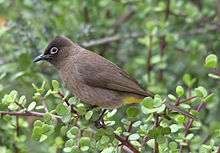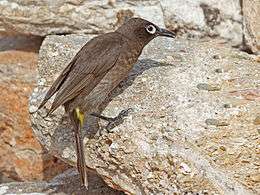Cape bulbul
| Cape bulbul | |
|---|---|
 | |
| In Addo Elephant National Park, Eastern Cape, South Africa | |
| Scientific classification | |
| Kingdom: | Animalia |
| Phylum: | Chordata |
| Class: | Aves |
| Order: | Passeriformes |
| Family: | Pycnonotidae |
| Genus: | Pycnonotus |
| Species: | P. capensis |
| Binomial name | |
| Pycnonotus capensis (Linnaeus, 1766) | |
 | |
| Synonyms | |
| |
The Cape bulbul (Pycnonotus capensis) is a member of the bulbul family of passerine birds. It is an endemic resident breeder in coastal bush, open forest, gardens and fynbos in western and southern South Africa. This species nests mainly in the southern spring from September to November. The nest is thick walled cup concealed by foliage in a small tree or shrub.
Taxonomy and systematics
The Cape bulbul was originally described in the genus Turdus. The Cape bulbul is considered to belong to a superspecies along with the Himalayan bulbul, white-eared bulbul, white-spectacled bulbul, African red-eyed bulbul, and the common bulbul.[2] Alternate names for the Cape bulbul include the Cape geelgat and two names used for other species (common and dark-capped bulbul).
Description
The Cape bulbul is 19–21 cm long, mainly dull, blackish brown with a diagnostic white eye-ring, and yellow undertail coverts. The head has a small crest. The short, straight bill, legs and feet are black and the iris is dark brown. The sexes are similar in plumage.
This species is much darker than the other South African bulbuls, and differs in the eye ring colour and brown lower belly, whereas the other dark bulbuls have a pale lower belly. The dark belly helps to identify juveniles, which lack the distinctive eye ring of the adult.
The most typical call of this species is a liquid whistle of two or more varied notes pit-peet-pitmajol, piet-piet-patata.
Behaviour and ecology
The Cape bulbul is a common and conspicuous bird, which tends to perch at the top of a bush. It is active and noisy, usually seen in pairs or small groups foraging for fruit, nectar and insects.
In part of its range, it gets parasitized by the Jacobin cuckoo.
Gallery
References
- ↑ BirdLife International (2016). "Pycnonotus capensis". IUCN Red List of Threatened Species. Version 2016.3. International Union for Conservation of Nature. Retrieved 26 March 2017.
- ↑ "Himalayan Bulbul (Pycnonotus leucogenys)". www.hbw.com. Retrieved 2017-03-23.
- Sinclair, Hockey and Tarboton, SASOL Birds of Southern Africa, ISBN 1-86872-721-1
External links
- Cape Bulbul - Species text in The Atlas of Southern African Birds.
- SASOL e-guide
- Biodiversity Explorer
- iSpot


